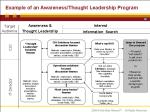Your “Customer Advisory Board” (CAB) Resource Center October 26, 2009
Posted by Mike Gospe in Customer Advisory Boards.Tags: CAB, CABs, Customer Advisory Board, Customer Advisory Boards, Customer Council, Integrated Marketing, marketing programs, marketing strategy, strategy, thought leadership
add a comment
The Dow is flirting around 14,000 and many expect signs of recovery to continue to blossom in 2013. Kicking off or rejuvinating your company’s CAB (or Customer Advisory Council – CAC) program is an excellent way to strengthen customer loyalty and ensure you are on the right (roadmap) track for 2013 and beyond.
I’ve been facilitating CABs and other executive summits and offsites for more than 10 years. Here is a collection of articles that offer insights, tips, and best practices that will help optimize your program and build stronger executive relationships.
- Are you getting strategic insight from your best customers?
Customer Advisory Boards help you validate and refine your product direction - What Came First, the CAB or the Executive Relationship?
- CAB or no CAB? That is the question
- A CAB Agenda to Engage Customers
- A Tale of 2 CABs: Feedback from the Front Lines
- How Three Collaboration Trends are Reshaping Marketing
- Customer Advisory Boards: Frequently Asked Questions
- Expect More Out of Meetings: Professional facilitators can keep your meetings focused and productive
- Anatomy of a Successful CAB
Characteristics of Effective Campaign Managers September 21, 2009
Posted by Mike Gospe in Integrated Marketing, Just for Campaign Managers, Marketing Operations.Tags: brand managers, campaign managers, Integrated Marketing, integrated marketing team, marcom mix, marketing best practices, marketing blueprints, Marketing Campaigns, Marketing Operations, marketing programs
add a comment
“I’m looking to hire a campaign manager to oversee our integrated marketing programs. What are the characteristics of the best campaign managers?”
I get asked this question a lot. Earlier in my career, I worked as a campaign manager at HP, Sun, and Ariba , so I’ve seen the good, bad, and the ugly. I’ll be up front with you and say that I’ve made my share of mistakes along the way. That experience opened my eyes to the marraige of marketing expertise with an appreciation for internal politics.
The biggest challenge campaign managers have is that they have a purview over an integrated marketing campaign (aka the “big picture”) but no direct authority over the team players who will execute the campaign. They walk a tightrope between meeting the campaign goals while aligning and carefully guiding a team of folks who have other masters. With that in mind, the most effective campaign managers have these traits in common:
- A recognized, well-rounded marketing leader familiar with the target market
- Proven leadership experience in “managing by objective” Attentive to detail, but smart enough not to micro-manage
- Diplomatic and politically savvy
- Patient
- A good facilitator, seasoned in active listening techniques
- Excellent written and oral communicator (with the team, to upper management, and in front of the steering committee)
- Knows when and how to provide constructive feedback in real time during team meetings; knows when and how to provide direct feedback in one-on-one settings
- Is prepared to make hard decisions and trade-offs for the greater good of the campaign
- Most of all, doesn’t let their ego get in the way of sound recommendations
There’s art and science in this role. The science comes from understanding sound marketing best practices. More important than understanding the specific products being sold, the best campaign managers bring an awareness and appreciation for the customer and their business problems and opportunities. While they usually won’t know all the answers, their expertise comes in knowing the right questions to ask the team in order to define, architect, and execute the best, most effective integrated marketing campaigns. That’s the art.
Looking for more information on integrated marketing campaigns? Please see Chapter 7 in Marketing Campaign Development.
Mechanics of a Lead Gen Blueprint June 16, 2009
Posted by Mike Gospe in Integrated Marketing.Tags: activities & offers, Integrated Marketing, lead funnel, Lead Generation, marcom mix, marketing blueprints, Marketing Campaigns, marketing programs
add a comment
Lead gen blueprints come in all shapes and sizes. However, there are common best practices that continually and consistently work well together. In my latest article, “Mechanics of a Lead Generation Blueprint” (as posted in the June KickStart Alliance enewsletter) I’ve highlighted aspects of both “push” and “pull” marketing activities and how they work well together to nurture prospects through the lead funnel.
This particular blueprint is centered around an upcoming webinar. Quite often, marketers focus on a single event (like a webinar) without considering all the valuable pre- and post-webinar marketing activities and offers required to maximize the number of qualified leads surrounding this event. Marketing is not about a singular event or activity. Marketing is a process that must be nurtured to drive the best results.
Have a look at the blueprint and feel free to shoot me questions and comments. I’ll continue to post various examples of other lead generation blueprints in the future.
Building an “Awareness/Thought Leadership” blueprint April 27, 2009
Posted by Mike Gospe in Integrated Marketing.Tags: awareness, Integrated Marketing, marketing blueprints, Marketing Campaigns, marketing programs, thought leadership
add a comment
One of the most common types of marketing programs are the “awareness & thought leadership” programs. This specific program has the objective of focusing the company on the business and solutions topics the customer cares about. Instead of immediately diving down to the feature-rich technical jargon, this program marks an important step to communicating to customer executives that we truly understand their business issues. It positions us as business partner, and thus allows us to take a consultative approach in dialoguing with customers and prospects.
Reading left to right, notice that we’ve identified the intended target audience on the left. (Personas would have been developed in detail prior to designing this blueprint.) Across the top, the customer’s buying behavior has been listed — in this case moving from “awareness” to “interest”. The first step of expressing interest is usually seen in the prospect searching for information. (This is not an comprehensive example; other forms of engaging in awareness and interest activities will be covered in future posts.) Like branding, this type of program is best viewed as an ongoing investment in creating and maintaining “aircover” for your marketing efforts that will frame specific product launches and promotions.
Each box in the blueprint references a “theme” and the “marketing methods” (i.e. articles, Web, executive presentations) used to communicate the theme. We cast our net wide by starting with business topics that should appeal to both the CIO and IT director. Popular themes can be thought of as the “what” themes: — What industry trends will influence the industry? or What impact can we expect the current economy to have on consumer behavior? or What are the three primary investment priorities for telco CIOs in 2010? For best results, a company may have one or two business themes that will be explored all year. It’s best to be focused.
Next, we move on to solutions-based themes. Think of these topics as “how” themes — How will companies balance containing costs while protecting the network? or How are companies maximizing the ROI of their outsourced functions and programs? These topics tend to get more specific in prescribing a criteria for success. For best results, a company may entertain 2-3 solutions topics that support each business theme, per quarter. This allows additional solutions topics to unfold over time, thereby providing flexibility to leverage new product launches and current events that may impact buyer behavior.
Notice that in neither the business-topics nor the solutions-topics have we put our product in the headline. This is important. The value that your company brings is in sponsoring these topics and providing business and solutions savviness. Via your sponsorship, customers will make the connection to your products and services. Like chapters in a book, these discussion topics will build and evolve each quarter, providing rich content for prospects to review and respond to.
But our marketing efforts are only just beginning. Ultimately, the best qualified leads are the ones who seek us out. So, we whet their appetite with our business and solutions topics, and we give them an opportunity to raise their hand to request more information. And, we’ll be on the look out for prospects who exhibit certain behavior based on the topics they find of interest and the information they share with us along the way. (I’ll share some best practices on establishing lead qualification criteria and scoring in a later blog post.) In either case, we’ll be ready. That’s when our demand generation programs kick in and we actively confirm that they are indeed qualified as we quickly stream them through the sales cycle.
Next month I’ll share an overview of a couple of blueprints for demand generation programs.
For more information, please read Marketing Campaign Development.





